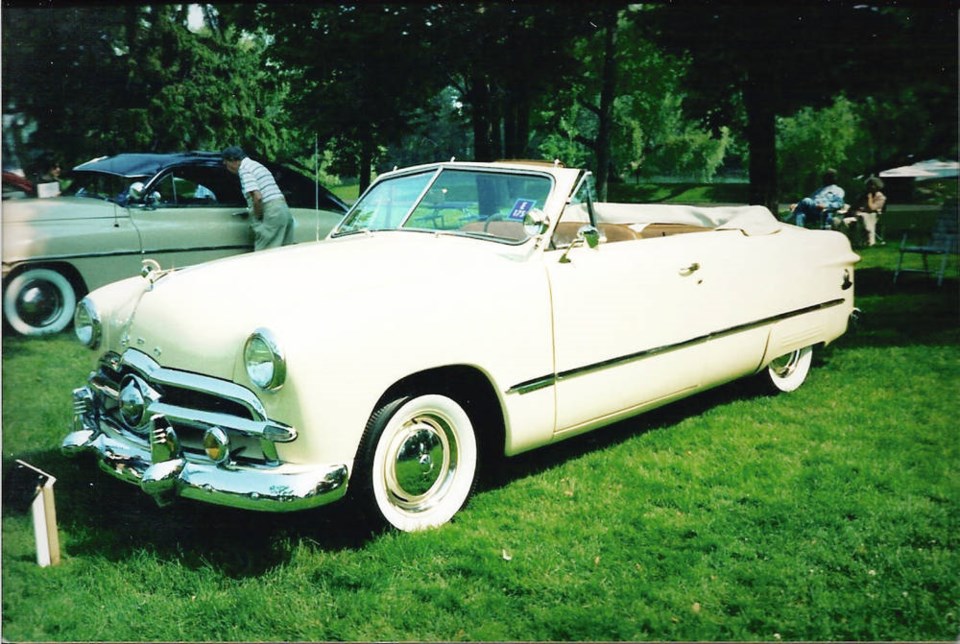As the Second World War neared its end in late 1944 American auto manufacturers were planning their conversion to civilian production. While General Motors and Chrysler made relatively seamless returns with warmed over 1942 models, things had not been quite a smooth at Ford.
Henry Ford had appointed his only son Edsel as company president in 1919 at the age of 25 but old Henry continued as ghost president in his chaotic and dictatorial style. Unfortunately Edsel died an untimely death in 1943 and Henry took over officially again.
But at age 80 Henry was not up to the job. He let Charles Sorensen his loyal aide of 40 years slip away, and came under the influence of the thuggish Harry Bennett, head of the Ford Service Department, a euphemism for the company police force.
Ford Motor Co. had many military contracts and the government was concerned about its stability. To rescue Ford and keep a Ford at the helm, Edsel’s eldest son Henry Ford II was released from the navy in 1944 and brought in as Ford’s executive vice-president.
Old Henry tried clinging to the presidency but his wife Clara and Edsel’s wife Eleanor “convinced” him to relinquish control, allowing Henry II to became president. Although only 27 and inexperienced, he had the right instincts; his first significant administrative act was firing Harry Bennett.
He then addressed Ford’s management and its obsolete cars. Old Henry had insisted on keeping solid front axles, transverse-leaf “buggy spring” suspension and mechanical brakes years after competitors had switched to more modern technology.
Like others, Ford returned to civilian production with face lifted 1942 models until it could create new post-war models.
HF II recognized the dire need for management assistance. Ford made a good start by attracting vice-president Ernest Breech and crack engineer Harold Youngren, both from GM.
Coincidentally, a group of bright, young (age 26 to 34), well-educated (mostly Harvard) demobilized Army Air Force officers led by Charles (Tex) Thornton banded together and offered Ford their services as management consultants.
HF II hired these “Whiz Kids” in 1946. Although knowing little or nothing about the auto industry they were quick learners and very capable. Thornton would later form Litton Industries. Six of the 10 ultimately became vice-presidents of Ford, two became Ford presidents. One, Robert McNamara, became United States secretary of defence in the Kennedy and Johnson administrations.
With strong management in place, the next requirement was state-of-the-art products. In mid-1947 Ernest Breech announced that Ford would have a new 1949 car by the summer of 1948, an extremely short deadline.
In spite of the tight schedule the new car was ready on time. A modern chassis was designed with independent coil-spring front suspension. The single transverse rear leaf spring was replaced by longitudinal “Para-Flex” leaf types. The usual three-speed, column-shift transmission was used, with overdrive available for extra fuel economy and quietness. The only carryover was the well proved side-valve 100 horsepower V-8
There was also a 3.7 litre (226 cu in.) 95 horsepower side-valve, inline six, although this was not offered in Canada. The engines were the only things carried over; everything else was new.
Company management invited new designs from an outside stylist named George Walker, formerly of Nash, and Eugene Gregorie, Ford’s own chief stylist. When a selection was conducted without company officials knowing who did each one, Walker’s design was chosen. Gregorie resigned four days later.
Walker’s talented group created a truly trend-setting shape, a full envelope body symmetrical front and rear. The fenders, hood and deck were on one plane and a large central “spinner” dominated the horizontal bar grille.
The new 1949 Ford was introduced at New York’s Waldort Astoria hotel on June 8, 1948. The public loved the clean attractive styling and demonstrated their approval by buying over a million ‘49 Fords, more than double 1948 model sales. There were some initial problems due to the rushed development, but these were gradually corrected.
The Ford was spirited for its period. Car tester Tom McCahill of Mechanix illustrated (Feb/50) reported acceleration to 60 mph (97 km/h) in15.9 seconds and a top speed of 92.3 mph (157 km/h).
The 1949 Ford has been credited with saving the Ford Motor Co. It put Ford back on its feet with new modern engineering and made it capable of going head-to-head with General Motors and Chrysler Corp. Ford had finally abolished Old Henry’s Model T mentality and the stigma of technical obsolescence. It was now a well managed corporation.
The company was poised for the epic production battles that would be waged by the Big Three in the 1950s. In 1952 Ford jumped back into second place in sales, ahead of Chrysler Corp., a position it had lost to Chrysler in 1936.



